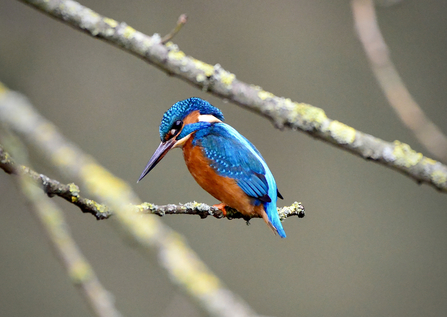Why does the river need restoration?
As it flows through Lake View Park, the River Sherbourne has changed heavily over the years. Previous generations made it too straight, and too deep. The lack of varying flow speeds in the river means silt builds up in the channel. This makes it difficult for fish to breed and makes it harder for plants in the water to get oxygen.
Throughout 2024 and into early 2025, the Sherbourne Valley Project aims to re-naturalise the River Sherbourne as it flows through Coventry. We will be widening and re-wiggling the river, creating more bends to create a variety of flow speeds in the river and help it hold more water. We are also introducing riffles (shallower, faster moving sections of a stream) using pebble banks which will also add to the variety of flow speeds, and provide a great habitat for fish to breed.
We will also create new ponds, shallow pools, and wetland areas near the river. This will improve the habitat for wildlife, creating more space for plants and creatures to thrive. By making these features more permanent, we will also increase the water storage capacity of the area, helping to reduce the impact of flooding downstream.
River work
The river at Lake View Park will be widened, adding more bends and natural river features such as riffles or pebble banks.
Channel Widening:
We will widen the river channel in four sections. Each section will be positioned at alternate strategic points to allow the river to meander and carry more water. These sections will also help to create slower and faster rates of flow, which in turn create a variety of habitats for plants and animals to live in.
Riffle Structures:
Pebbles and stones will be placed in carefully-selected areas of the river, creating rocky, shallow sections with faster moving water.
These shallow, fast-moving sections of the river will be ideal for breeding fish and will provide oxygen-rich habitats for plants.
The variation in flow speeds and depth supports a wider range of species, from insects to larger fish. The gravel and faster flowing areas help to aerate the river, improving water quality.
Inset Floodplain:
In one area, the banks of the river will be lowered to create an inset floodplain, where the Guphill Brook meets the river Sherbourne. We will create a natural slope to help wildlife access the river.
This floodplain will become a wet, fertile area, supporting diverse plant and animal life, which will also help distribute nutrients, enriching the soil and promoting healthy vegetation.
Other work
Ponds:
Four ponds of different shapes and sizes will be dug in the park in areas where the park naturally floods. They will all be wildlife ponds, with shallow edges to help wildlife enter and exit. We will also maximise the habitat at the edge of the ponds and this will help to house many plants, animals and insects.
Ponds provide a consistent water source for wildlife, even during dry periods. These ponds will attract a variety of species, from amphibians to birds, enhancing local biodiversity.
Scrapes:
Three scrapes will be created in Lake View Park. Scrapes are shallow ponds, less than 1m in depth, which hold rain or flood water seasonally, but stay damp for most of the year.
Scrapes provide breeding and feeding grounds for wading birds and other wildlife, they also act as temporary water storage areas during high rainfall, helping to manage floodwaters.
Wetlands:
Two wetland areas in the North-East section of the park will be created by enhancing existing low-lying areas to retain water more effectively. Wetlands are areas where water covers the soil, or is present either at or near the surface of the soil throughout the year. They are shallower than ponds and they will function as a species-rich habitat close to the river.
Wetlands naturally filter pollutants from the water, improving overall river health. They also absorb carbon dioxide, helping to mitigate climate change. They support a wide range of plant and animal species, creating a vibrant and dynamic ecosystem.
Removal of sediment from blocked bridge culvert:
As part of the project, we will be removing a build-up of sediment which has accumulated in the culvert underneath the bridge. This will allow the river to reconnect to the existing channel through the wetland area of the park, and will help fish to use this channel to migrate both up and downstream.
Where will all the soil go?
The soil (sometimes referred to as spoil) will be kept on-site in the park, and will be used to add to existing mounds covered in either grass or wildflower seeds.
How long will it take?
The restoration work is estimated to take 5-6 weeks to complete, depending on the weather. You can expect to see some heavy machinery and lots of soil whilst the work takes place. Works will take place out of bird nesting and fish breeding season, and will ultimately improve the area for both people and wildlife.
Access will be considered in the plans and delivery, although access to the park will be restricted for a few weeks whilst work is taking place. Dog walking will still be possible along advised alternate routes, and general access in the park will be improved in a separate project shortly after the restoration work is completed.

Kingfisher by David Edwards
